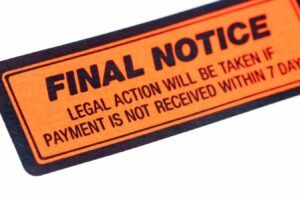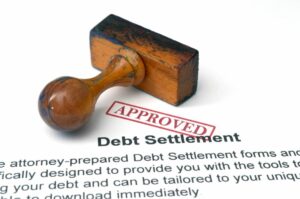8 Facts about Debt Settlement You Need to Consider
Credit card debt settlement may be the right solution for your situation. But the debt relief option comes with a cost to your wallet – and your credit.
If you’re facing challenges with credit card debt – particularly debts that have gone to collections – then you may have received some offers from companies that claim they can settle your debt for “pennies on the dollar.” The solution they’re referring to is known as debt settlement, or debt resolution. You literally settle a debt for less than the full amount you owe. But it’s not without its risks and pitfalls.
Debt settlement can cause damage to your credit up to seven years. It’s also an industry that has long been plagued by bad actors who charge customers fees before settling any of the debt they owe. The debt settlement industry as a whole has been cleaning up its act, as per the law set by the Federal Trade Commission.
There are plenty of reputable debt settlement companies who can provide a solution for some consumers. While debt settlement can be a good solution in certain situations, you need to know what you’re getting into before you sign up for the program – and how to tell the good companies apart from the bad ones.
#1: “Pennies on the dollar” can be more money than you might think
Debt settlement companies tend to use the catchphrase “pennies on the dollar.” That almost makes it sound like you can get out of debt with the loose change stuck in your couch cushions. But that’s not really the case.
According to the American Association for Debt Resolution, the average settlement amount is 50.7% of the balance owed.[1] So yes, if you owed a dollar, you’d get out of debt for fifty cents. But the average amount of debt enrolled is $4,500. That means you should still expect to pay a hefty sum to get out of debt. The more you owe, the more money you’ll need to settle your debts.
#2: You could still end up making monthly payments for up to 4 years
Debt settlement still requires money to make settlement offers. Creditors and collectors won’t forgive your balances and get nothing in return; you must pay them something. So, you need to generate money for a settlement.
Here’s how to works:
- You enroll in a settlement program through a debt settlement company.
- They create a monthly “set aside account” to gather the funds you need to make the settlement offers.
- You make monthly payments into a set aside account to generate the funds you need for settlement – this is called a “monthly set aside.”
- Once you have enough funds, the company negotiates with your creditors and collectors to agree to a settlement.
- As settlements are negotiated, they take funds out of the set-aside account.
So, you’re still going to end up making monthly payments, even with a settlement program. And a settlement program can take anywhere from 12 to 48 months, depending on how much you owe and how much you can set aside each month.
What if I don’t have any money to make monthly payments?
If you’re wondering where you get the money to make the monthly set aside, it depends on the settlement company. Reputable companies will review your budget and help you cut back to generate the biggest monthly set aside possible. But some disreputable companies may advise you to stop making any payments to your creditors and use that money for the monthly set aside instead.
If you encounter this, walk away! It’s illegal for a debt settlement company to advise you to stop making payments to your creditors. So, if a company does this, it’s a good sign that you aren’t working with a reputable company and it may be a scam. In this case, don’t sign up for anything or pay any fees. Instead, look for a different, more reputable settlement company to help you.
#3: Credit settlement will hurt your credit score
When you settle a debt, the account status will be noted as “settled in full” rather than “paid in full.” When an account is closed with a settled in full notation, it stays on your credit report for seven years from the date of final discharge. That notation is a bad mark on your credit history, which is the number one factor used in calculating credit scores. So, each debt you settle will damage your credit score.
But if your accounts are already in collections, they already count negative remarks on your credit report. If you already have multiple collection accounts listed in your report, the damage has already been done to your score. Essentially, it’s the old adage that you can’t fall off the floor. If your credit score is already bad, there’s less risk to settling your debt.
On the other hand, if you have a good score – or even a fair one – then you should expect the settlement to drag your score down. You need to consider carefully what will happen once you get out of debt. It’s definitely possible to rebuild your credit, but you want to limit the damage whenever possible as you eliminate your debt.
#4: Settlement works best if your debts are already with third-party collectors

Although the average settlement amounts to 50.7% of what you originally owed, that number is a bit skewed. If your debts are still with the original creditor, settlement amounts tend to be much higher. You can end up paying up to 80% of what you owe if the debt is still with the original creditor.
Settlements tend to be higher with original creditors because they want to recoup as much of their loss as possible. But with a debt collector, they purchased your debt from the original creditor for a small percentage of what you actually owed. So essentially, they can accept a lower settlement amount and still make a profit.
If your debts are already in collections, the damage to your credit score is already done. You want to get collection debts discharged as quickly as possible, so you can get to recovery and rebuilding your credit faster.
#5: You won’t have to pay any fees until your debts are settled
In 2010, the Federal Trade Commission (FTC) enacted the advance fee ban on debt settlement companies. The rule prohibits any debt relief company “from charging fees before settling or reducing a customer’s credit card or other unsecured debt.” [2]
This means a debt settlement company can’t charge you any fees until they’ve officially settled at least one of your debts. So, you shouldn’t be required to pay any setup or monthly administration fees on a debt settlement program. If you do, then the company must offer a money-back guarantee. If they don’t, it’s a sure sign of a debt settlement scam.
If you encounter a debt settlement company requesting fees upfront, not only should you walk away, you should report the company to the FTC. You can file a complaint online at ftc.gov/complaint or call 1-877-FTC-HELP (1-877-382-4357).
#6: Settlement fees are high compared to other debt relief options
The way that fee structures tend to work with accredited debt settlement companies is that you pay a percentage of the debt that was settled. This means fees can stack up to thousands of dollars, depending on how much you owe. Settlement fees are generally high compared with other solutions. For example, fees on a debt management program are capped at $79 per month and the average DMP client pays about $40.
But as the American Fair Credit Council explains, the cost savings of a settlement usually outweigh the fees. They provide this example: [1]
- A customer owes $10,000 in credit card debt.
- The debt is settled for $4,000.
- The fee applied is 20% of the debt owed, which comes out to $2,000.
- So, the cost savings is $4,000 ($6,000 saved on debt repayment minus the $2,000 fee).
Essentially, you’re going to pay a debt settlement company a pretty penny to get you out of debt. But if the company does their job and gets you the best settlement possible, you should still save money.
#7: The older your debt is, the less reason there is to settle

Every state has a statute of limitations on how long a debt collector has to sue you in civil court to force repayment of a debt. The maximum statutes are 10 years. So, regardless of where you live there’s no more than a 10-year window where a collector can take you to court to collect on a debt.
You should check with your state Attorney General’s office to find out what the specific statute of limitations is for your state. If your debts are old and close to that statute, there’s less reason to pay them anything. After 10 years they can still contact you to attempt to collect, but they have no legal recourse. And if you tell them to stop contacting you, they must honor that request.
If you have any debts that are over that statute and the collector is still bothering you, send them a cease and desist letter using the template you can find below. Just be careful to keep the wording close to what it says in the template. If you’re not careful and you acknowledge that you owe the debt in any way, you can actually reset the clock on the statute of limitations!
#8: As debts get closer to the statute of limitations, collectors will take what they can get
The statute of limitations provides a legal deadline protecting you from debt collection lawsuits. After it expires, you can’t be sued, though the debt is still owed.
The statute of limitations on debt can be used as a bargaining chip for negotiating a lower settlement amount. As a debt gets closer to that statute, the collector will be willing to take what they can get. So, you can get out of debt for a lower percentage of what you owe as the clock runs out.
In some cases, you may be able to settle for much less than that 50.7% average. Collectors holding old debts may be willing to settle for 20% or even less. The statute of limitations clock starts from the date the debt first became delinquent. Make sure to check your records carefully and use the age of a collection account to your advantage during negotiations.
CAUTION: If you pay on a debt after the statute of limitations has expired, you essentially reactivate it, giving debt collectors a new window to sue.
Is debt settlement worth it?
As with any debt relief solution, deciding if credit card debt settlement is worth it really depends on your financial situation. This simple three question test can help you decide:
Talk to a certified credit counselor today for a free debt and budget evaluation so you can identify the best option for debt relief in your situation.
How to assess your personal credit settlement risk

Credit card debt settlement is a financial risk because you must go into it with the understanding that it will damage your credit. Your current credit score and how far you have to fall credit-wise are not the only considerations you need to have. You must also consider any upcoming financing you wish to secure following your settlement.
- You will most likely find it difficult to get approved for traditional unsecured credit cards.
- If you want a credit card, you will probably need a cash deposit, so you can get a secured credit card.
- Your credit score may also make it hard to qualify for loans, including mortgages and auto loans.
How to negotiate credit card debt settlement yourself
If your debts are already in collections and you’re receiving settlement offers, then you may not need a professional debt settlement company to handle the negotiation for you. Instead, you may be able to save yourself some money and handle the debt negotiation yourself.
To do this, you will want to send formal letters to each of the collectors or creditors that hold your debts. Here is the step-by-step process for do-it-yourself credit card debt settlement:
- First set up a budget to determine how much you can afford to offer in settlements and when.
- Prioritize the debts you want to settle to determine the order that you’ll make your settlement offers.
- Any old debts that are close to the statute of limitations on collections in your state should be at the bottom of the list.
- Now look at each debt and decide how much you want to offer.
- Make sure to consider how long the debt has been in collections and see if the collector has already sent you any correspondence with a settlement offer.
- For any debts that you’ve received an offer, use the counteroffer settlement letter below to negotiate a lower percentage.
- If you haven’t received a settlement offer from the collector, then decide how much you’re willing to offer them as a starting point for the negotiation.
- Once a settlement amount is reached with a collector, they will send you a formal settlement agreement.
- Sign it and make a copy for your records. Then send the signed copy back to the collector.
- Once they receive the money you owe, they will discharge the remaining balance and report the debt as settled in full to the credit bureaus.
Tips for making settlement offers
- Always keep the age of the collection account and the statute of limitations in mind when making an offer. Remember that the older a debt is, the less it will take to settle.
- If a debt is still with the original creditor, realize that it will most likely take a higher percentage of what you owe to settle the debt.
- Always handle all negotiation in writing! Don’t try to make settlement agreements over the phone.
- During debt negotiation, be aware that acknowledging that you owe a debt can reset the clock on the statute of limitations. This is another reason why you may not want to negotiate on older debts.
- Take note of the date of final discharge of the remaining balance. You need to know this, so you can ensure settlement notations on your credit report are removed after seven years.
Debt Settlement Letter Templates
If you want to negotiate a credit card debt settlement yourself, these templates can help you handle the debt negotiation in the best way possible.
Settlement offer letter template
Use this letter to make an initial offer to a debt collector that has not tried to contact you already with a settlement proposal.
Download a free settlement offer template »
Settlement counteroffer letter template
This template should be used to make a counteroffer if a debt collector has already sent you a settlement proposal. This letter can help you get out of debt for even less.
Download our free settlement counteroffer letter template »
Debt collection cease and desist letter
This letter template should be sent to tell a collector that you no longer wish to be contacted. If the debt is past the statute of limitations for collection in your state, this should stop any further hassle for that debt. If the debt has not passed its statute of limitations, then the collector’s only recourse would be to sue you in civil court.
Download our free cease & desist collection letter template »
Debt Settlement FAQ
In most cases, the collector will want payment in a single lump sum. This is why debt settlement companies tell you to stop any payments and divert the money to a monthly set aside, so you can generate the funds to make lump-sum settlement offers.
However, if you are receiving settlement offers from a collector, you can ask if they’d be willing to accept the settlement in installments.
No. We provide debt management programs, which are significantly different from settlement. However, our certified credit counselors can advise you if settlement would be the better option for relief, based on your situation.
Seven years from the date of final discharge.
Settlement is usually the cheapest option to get out of debt and the fastest. On the other hand, it’s also the worst for your credit score.
The average is 48% of the original amount owed. You can get out of debt for a lower percentage if:
– The debt is with a collector, rather than the original creditor
– The debt is close to the statute of limitations on collection in your state.
Debt settlement is your best option for relief if a debt is already in collections. Once a credit card debt goes to a third-party debt collector, interest charges no longer apply to the debt. The collector also can’t add any additional fees.
So, many of the benefits offered by a debt management program – reducing or eliminating interest charges and stopping future penalties – won’t be beneficial with debts that are already with a collector. However, if most of your other debts are current and you want to include a debt that’s in collections in your debt management program, you can do so.
Not sure which debt relief option is right for you? Talk to a certified credit counselor to weigh your options so you can find the best solution for your needs.
